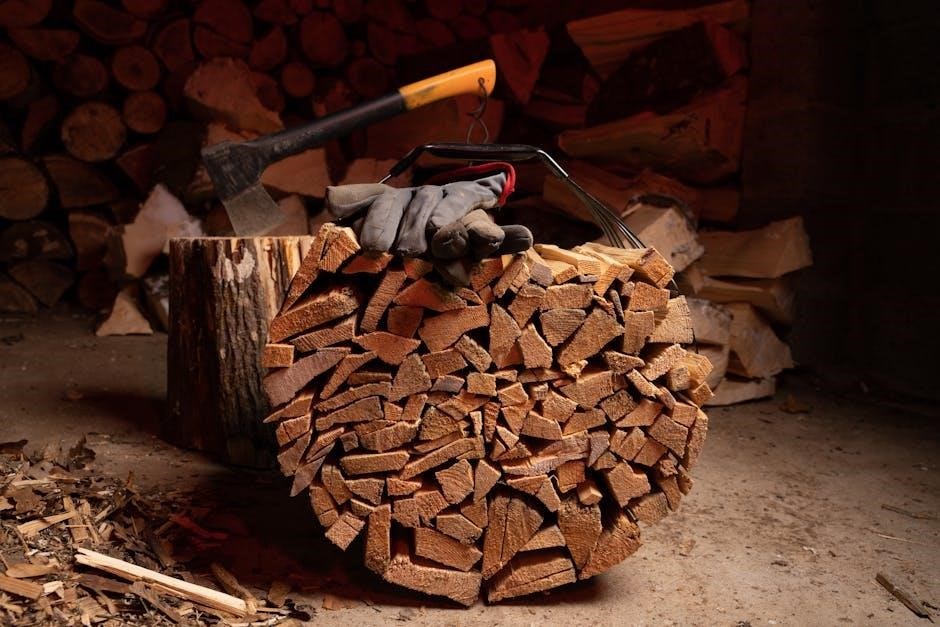Manual sawmills offer a cost-effective, eco-friendly solution for precise lumber production. Ideal for woodworking enthusiasts and small-scale producers, they provide an affordable alternative to commercial milling services.
1.1 What is a Manual Sawmill?
A manual sawmill is a DIY tool designed to convert logs into usable lumber without industrial machinery. It offers a cost-effective, eco-friendly solution for woodworking enthusiasts and small-scale producers. Unlike commercial sawmills, manual sawmills are typically portable, easy to assemble, and require minimal investment. They provide precise control over lumber production, making them ideal for crafting custom wood products. Available in types like bandsaw or chainsaw mills, these tools empower users to mill lumber sustainably and efficiently, perfect for homesteaders or hobbyists seeking to save money and reduce environmental impact.
1.2 Benefits of Using a Manual Sawmill
Manual sawmills offer numerous benefits, including cost-effectiveness, portability, and environmental sustainability. They allow users to mill lumber on-site, reducing transportation costs and waste. With precise control, they enable the creation of custom-sized lumber, perfect for woodworking projects. Manual sawmills are ideal for small-scale production, providing an affordable alternative to industrial mills. They also promote self-sufficiency, empowering users to process logs independently. Additionally, they are eco-friendly, as they often require less energy and produce minimal waste compared to commercial operations, making them a practical choice for homesteaders and hobbyists alike.
1.3 Brief History of Manual Sawmills
Manual sawmills have evolved from traditional woodworking tools, with early versions using simple mechanisms to cut lumber. Over time, innovations like bandsaw and chainsaw mills emerged, offering greater efficiency. Historically, these mills were essential for small-scale logging and homesteading, providing a cost-effective way to process wood. Modern designs incorporate detailed plans and DIY approaches, making them accessible to hobbyists and professionals alike. The development of portable and compact models has further expanded their utility, ensuring manual sawmills remain a vital tool for sustainable woodworking practices.
Types of Manual Sawmills
Manual sawmills include bandsaw, chainsaw, and portable models, each offering unique capabilities for cutting logs into lumber. They cater to various woodworking projects and user preferences effectively.
2.1 Bandsaw Mills

Bandsaw mills are a popular choice for manual sawmilling, offering precise cuts and efficient lumber production. They feature a continuous loop blade, ideal for processing large logs into usable timber. These mills are known for their stability and smooth operation, making them suitable for both small-scale and homestead projects. Detailed plans and blueprints are widely available, guiding DIY enthusiasts through construction. With heavy-duty builds and step-by-step instructions, bandsaw mills are a reliable option for those seeking to mill lumber with accuracy and control, supported by comprehensive resources for successful assembly and operation.
2.2 Chainsaw Mills

Chainsaw mills are portable, cost-effective tools for milling lumber, ideal for remote locations. They utilize a standard chainsaw bar and chain, making them versatile for various projects. These mills are lightweight and easy to transport, perfect for processing logs on-site. Detailed plans and instructions are available for DIY setups, allowing users to create custom configurations. Chainsaw mills are a practical choice for small-scale operations, offering flexibility and affordability. They are particularly popular among homesteaders and woodworkers seeking to mill lumber without heavy machinery, supported by accessible guides and tutorials for successful operation and maintenance.
2.3 Portable Sawmills
Portable sawmills are versatile, lightweight, and designed for on-site lumber production. They are ideal for processing logs in remote locations, offering flexibility and ease of transport. These mills are perfect for small-scale operations, homesteaders, and woodworkers. Detailed plans and instructions are available for DIY setups, allowing users to customize their mills. Portable sawmills are cost-effective and eco-friendly, enabling precise cuts and minimal waste. They are a practical solution for milling lumber without the need for heavy machinery, making them a popular choice for various woodworking projects and applications.
Tools and Materials Needed
Essential tools include welding equipment, power saws, and measuring tools. Materials like steel, angle iron, and durable wood are required for constructing a sturdy frame and track system.
3.1 Essential Tools for Building a Manual Sawmill
Building a manual sawmill requires essential tools like welding equipment, circular saws, drills, and measuring tools. A bandsaw or chainsaw is necessary for cutting logs. Steel cutting tools and angle grinders are also vital for refining metal components. Additionally, clamps, wrenches, and screwdrivers are needed for assembly. For precision, consider using a CNC machine or laser cutter for intricate cuts. These tools ensure the sawmill’s frame, track, and drive system are built accurately and durably, making the milling process efficient and safe.
3.2 Materials Required for Construction
Building a manual sawmill requires sturdy materials, including steel for the frame and track system. Angle iron (25mm x 25mm) is ideal for the track’s durability. Heavy-duty wheels and axles ensure smooth operation. Saw blades, preferably high-carbon steel, are essential for precise cuts. Additional materials include bolts, nuts, and welding rods for assembly. Optional components like a steel bed or roof can enhance functionality; These materials ensure the sawmill is robust, reliable, and capable of handling various log sizes efficiently.
Safety Considerations
Operating a manual sawmill requires strict adherence to safety guidelines to prevent accidents. Always wear protective gear and ensure proper blade alignment before cutting. Regular maintenance is crucial.
4.1 Safety Precautions While Operating a Manual Sawmill
Always wear protective gear, including safety glasses, gloves, and a dust mask. Ensure loose clothing is secured to avoid entanglement. Keep bystanders at a safe distance. Before cutting, verify blade alignment and tighten all components. Never operate the sawmill when fatigued or distracted. Regularly inspect blades for damage and sharpen or replace them as needed. Properly lubricate moving parts to prevent overheating. Follow detailed safety guidelines in your manual to minimize risks and ensure smooth operation. Maintenance and caution are key to avoiding accidents.
4.2 Protective Gear and Equipment
Essential protective gear includes safety glasses, gloves, and a dust mask to prevent injuries from debris. Hearing protection is crucial due to loud machinery noise. Steel-toe boots safeguard feet from heavy objects. A first aid kit should always be nearby. Proper attire, free from loose ends, reduces entanglement risks. Ensure all gear meets safety standards for optimal protection. Regularly inspect equipment for wear and tear. Adequate protective gear minimizes hazards, ensuring a safer working environment while operating a manual sawmill.

Assembly and Construction
Building a manual sawmill involves assembling the frame, track system, and drive mechanism. Detailed plans guide the process, ensuring proper construction for functionality and safety.
5.1 Step-by-Step Guide to Assembling the Sawmill Frame
- Gather all materials, including angle iron, steel plates, and fasteners, as specified in your plans.
- Cut frame components to exact measurements using a saw or cutting torch.
- Assemble the base frame, ensuring it is square and sturdy for stability;
- Construct the sawmill head, attaching it securely to the base frame.
- Align and weld all joints carefully to maintain structural integrity.
Following detailed plans ensures accuracy and safety during assembly. Proper alignment and welding are critical for a durable and functional frame.
5.2 Building the Sawmill Track System
The track system is crucial for guiding the sawmill’s movement during cutting. Construct it using durable materials like angle iron or steel rails for stability and precision.
- Cut the track components to the specified lengths, ensuring they align perfectly.
- Assemble the track on a flat surface, securing it with bolts or welds for rigidity.
- Mount the track system to the sawmill frame, ensuring it is level and properly aligned.
- Test the system by moving the sawmill head along the track to confirm smooth operation.
Accurate assembly ensures consistent cuts and extends the lifespan of your sawmill.
5.3 Installing the Drive System
The drive system powers the sawmill’s cutting mechanism, ensuring efficient and precise lumber production. It typically includes a motor, pulleys, and belts or gears.
- Mount the motor securely to the sawmill frame, aligning it with the drive shaft.
- Attach pulleys or gears to the motor and saw blade, ensuring proper alignment for smooth power transfer.
- Connect the belts or gears, adjusting tension to prevent slippage during operation.
- Test the system at a low speed to ensure all components function harmoniously.
A well-installed drive system maximizes cutting efficiency and reduces wear on moving parts.

Maintenance and Upkeep
Regular maintenance ensures optimal performance and longevity of your manual sawmill. Tasks include lubricating moving parts, sharpening blades, and checking for wear and tear.
6.1 Regular Maintenance Tasks
Regular maintenance is crucial for ensuring the longevity and efficiency of your manual sawmill. Key tasks include lubricating moving parts, sharpening or replacing blades, and checking for wear and tear. Additionally, inspect the track system for alignment issues and clean debris from the sawmill frame. Properly storing the sawmill in a dry, protected area when not in use also prevents rust and damage. Following a consistent maintenance schedule helps maintain precision cutting and prevents costly repairs down the line.
6.2 Sharpening and Replacing Saw Blades
Sharpening and replacing saw blades are essential for maintaining optimal performance. Blades should be sharpened every few days, depending on usage, using a grinder or file. Always follow the manufacturer’s instructions for proper sharpening techniques. If a blade becomes excessively worn or damaged, replace it immediately to avoid poor cutting results. Regular blade maintenance ensures precise cuts, extends tool life, and enhances safety. Properly sharpened blades also reduce the risk of kickback and improve overall milling efficiency, making it a critical part of manual sawmill upkeep.

Troubleshooting Common Issues
Troubleshooting common issues with manual sawmills involves addressing blade dulling, misalignment, and motor strain. Regular maintenance and proper alignment can prevent most problems, ensuring smooth operation.
7.1 Common Problems and Solutions
Common issues with manual sawmills include blade dulling, misalignment, and motor strain. Dulling can be resolved by sharpening or replacing blades. Misalignment often requires adjusting the track system. Motor strain may indicate overloading, so reducing log size helps. Regular lubrication of moving parts and checking for wear on components like belts and bearings is essential. Proper maintenance and timely repairs ensure optimal performance and extend the sawmill’s lifespan. Addressing these issues promptly prevents downtime and enhances productivity.
7.2 Blade Alignment and Adjustment
Proper blade alignment and adjustment are crucial for accurate cuts and safety. Misaligned blades can lead to uneven cuts or damage to the sawmill. To adjust, ensure the blade is tensioned correctly and aligned with the track system. Use a wrench to tighten or loosen the adjustment bolts, and check the blade’s position with a gauge or ruler. Regularly inspect the blade for wear and adjust as needed to maintain optimal performance. Proper alignment ensures smooth operation and extends the blade’s lifespan, while preventing potential hazards during use.

Cost-Effectiveness of Manual Sawmills
Manual sawmills are a cost-effective solution for milling lumber, offering significant savings compared to commercial services. They reduce expenses by enabling DIY production, with free plans available online.
8.1 Initial Investment and Long-Term Savings
Manual sawmills require an initial investment in materials and tools, but they offer substantial long-term savings. By milling lumber yourself, you avoid costly commercial services. Free DIY plans and detailed blueprints reduce initial expenses, while the ability to process logs into usable lumber ensures sustained financial benefits. Over time, the savings from producing custom-sized wood outweigh the upfront costs, making manual sawmills a cost-effective solution for woodworking projects and small-scale production.
8.2 Comparing Costs with Commercial Sawmills
Manual sawmills are significantly more cost-effective than commercial sawmills. While commercial services charge per board foot, manual sawmills allow you to mill lumber at home, eliminating ongoing fees. Initial setup costs are lower, especially with free DIY plans and detailed guides available online. Over time, the savings from producing custom-sized lumber without relying on commercial mills add up, making manual sawmills a financially sustainable choice for woodworking projects and small-scale production needs.
Environmental Benefits
Manual sawmills are eco-friendly, reducing waste and optimizing lumber usage. They minimize carbon footprint compared to industrial mills, promoting sustainable woodworking and responsible resource management.
9.1 Eco-Friendly Aspects of Manual Sawmills
Manual sawmills are inherently eco-friendly, reducing waste by optimizing lumber usage. They operate with minimal environmental impact, using less energy than industrial mills. By processing logs locally, they cut transportation emissions, promoting sustainable forestry practices. These sawmills encourage responsible resource management, ensuring trees are used efficiently. Their smaller scale reduces carbon footprint, making them a greener alternative for woodworking enthusiasts and small-scale producers. This sustainable approach aligns with environmental conservation goals, supporting eco-conscious projects and reducing reliance on large-scale, resource-intensive milling operations.
9.2 Reducing Waste and Optimizing Lumber Usage
Manual sawmills excel at minimizing waste by allowing precise cuts, ensuring maximum lumber yield from each log. Their ability to process logs locally reduces waste from transportation and handling. By optimizing board sizes and reducing offcuts, these sawmills help conserve resources. This approach supports sustainable woodworking, enabling users to create exactly what they need while minimizing excess material. The efficiency of manual sawmills makes them a valuable tool for eco-conscious projects, promoting responsible lumber usage and reducing environmental impact.

Case Studies and Success Stories

Many DIY enthusiasts have successfully built manual sawmills, sharing their journeys online. Users like TexasBen and others showcase projects, from small-scale mills to large log handling, inspiring builders.
10.1 Examples of Successful Manual Sawmill Projects
One notable project is TexasBen’s detailed sawmill plans, which inspired many builders to create functional mills. A 134-page guide for a wide slabber bandsaw mill enabled users to handle 76-inch diameter logs efficiently. Another success story involves a novice who built a Procuts portable mill, demonstrating accessibility for first-time builders. These examples highlight how manual sawmills empower individuals to produce high-quality lumber affordably, fostering creativity and sustainability in woodworking projects.
10.2 User Testimonials and Reviews
Users praise manual sawmills for their affordability and functionality. One customer highlighted the detailed plans, calling them “incredibly detailed with essays and drawings.” Another shared success with a novice-friendly mill, stating, “I built it without prior experience.” Testimonials often mention cost savings and the ability to produce high-quality lumber. A satisfied user noted, “It paid for itself in the first project.” Reviews consistently emphasize the value and versatility of manual sawmills, making them a popular choice for woodworking enthusiasts and small-scale producers.

Manual sawmills empower individuals to sustainably produce lumber with cost savings and environmental benefits, making them a valuable tool for woodworking enthusiasts and small-scale producers alike.
11.1 Final Thoughts on Manual Sawmills
Manual sawmills are a practical, eco-friendly solution for woodworking enthusiasts and small-scale producers. They offer cost savings, precision, and the satisfaction of creating custom lumber. With detailed plans and community support, building a manual sawmill is achievable for novices and experienced craftsmen alike. This sustainable tool not only empowers individuals but also fosters a deeper connection to woodworking traditions. Whether for personal projects or small businesses, manual sawmills prove to be a valuable investment in creativity and self-sufficiency.
11.2 Encouragement to Build Your Own Manual Sawmill
Building your own manual sawmill is a rewarding and empowering project that offers a sense of accomplishment and control over your woodworking endeavors. With detailed plans and tutorials readily available, even novices can successfully construct a functional sawmill. The satisfaction of milling your own lumber, coupled with the cost savings and environmental benefits, makes this project a worthwhile investment of time and effort. Embrace the challenge and join the growing community of DIY enthusiasts who have transformed their woodworking experiences through manual sawmills.
